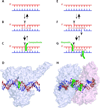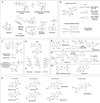Drugging topoisomerases: lessons and challenges
- PMID: 23259582
- PMCID: PMC3549721
- DOI: 10.1021/cb300648v
Drugging topoisomerases: lessons and challenges
Abstract
Topoisomerases are ubiquitous enzymes that control DNA supercoiling and entanglements. They are essential during transcription and replication, and topoisomerase inhibitors are among the most effective and most commonly used anticancer and antibacterial drugs. This review consists of two parts. In the first part ("Lessons"), it gives background information on the catalytic mechanisms of the different enzyme families (6 different genes in humans and 4 in most bacteria), describes the "interfacial inhibition" by which topoisomerase-targeted drugs act as topoisomerase poisons, and describes clinically relevant topoisomerase inhibitors. It generalizes the interfacial inhibition principle, which was discovered from the mechanism of action of topoisomerase inhibitors, and discusses how topoisomerase inhibitors kill cells by trapping topoisomerases on DNA rather than by classical enzymatic inhibition. Trapping protein-DNA complexes extends to a novel mechanism of action of PARP inhibitors and could be applied to the targeting of transcription factors. The second part of the review focuses on the challenges for discovery and precise use of topoisomerase inhibitors, including targeting topoisomerase inhibitors using chemical coupling and encapsulation for selective tumor delivery, use of pharmacodynamic biomarkers to follow drug activity, complexity of the response determinants for anticancer activity and patient selection, prospects of rational combinations with DNA repair inhibitors targeting tyrosyl-DNA-phosphodiesterases 1 and 2 (TDP1 and TDP2) and PARP, and the unmet need to develop inhibitors for type IA enzymes.
Figures




References
Publication types
MeSH terms
Substances
Grants and funding
LinkOut - more resources
Full Text Sources
Other Literature Sources
Medical
Research Materials

